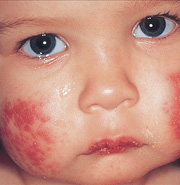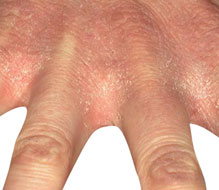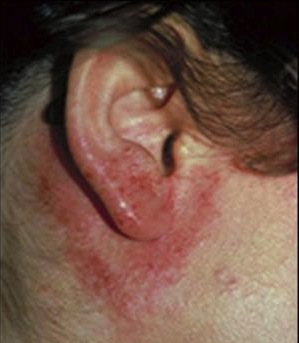Allergic Contact Dermatitis – Pictures, Symptoms, Treatment
What is Allergic Contact Dermatitis?
Allergic Contact Dermatitis is a medical diagnosis in which a person experiences itchy skin that is brought about by an allergic reaction from a certain material coming in contact with the person’s skin. Other medically inclined experts would define it as a contact dermatitis form that has an allergic manifestation response and is due to the irritant substance contact.
Allergic Contact Dermatitis on the side of the neck after wearing jewelry
Medically speaking, this is a prevalent kind of immunotoxicity associated in human beings. Due to the fact that it is allergic in nature, this is a widely known as a hypersensitivity reaction. Hence, it is medically termed as Type IV delayed hypersensitivity reaction which involves the allergic response that is cellular mediated. Aside from that, Allergic Contact Dermatitis is known to rise from the two vital stages known to be the induction phase, where the sensitization is experienced and the other is termed as the anelicitation phase, where the response has been triggered. Most often, the substances that one is allergic to are considered to be harmless such as cotton and the like. Yet, there are persons who have developed hypersensitive reactions to harmless substances.
Allergic Contact Dermatitis Symptoms
Persons suffering from Allergic Contact Dermatitis will experience the following symptoms similar to that of persons suffering from irritant contact dermatitis which leads to a hard diagnosis to begin with. The symptoms from Allergic Contact Dermatitis are as follows:
- Skin lesions
- Blisters
- Vesicles
- Papules
- Simple reddish area
- Itching
- Inflammation
- Swelling that is localized
- Tender to touch
- Warmth area
- Leathery skinned
- Darkened skinned
- Burning sensation
The first sign that the person with Allergic Contact Dermatitis will observe or notice is a visible red rash. It may not appear for a period of one to two days after being exposed to the irritant. Also, one must know that when the reaction will start; it may take for about a month to completely resolve and return back to normal.
Allergic Contact Dermatitis Causes
Different persons who acquire Allergic Contact Dermatitis will experience different kinds of causes or etiological reasons as to why. The following common causes linked to Allergic Contact Dermatitis are as follows:
- Exposure to poison sumac
- Exposure to dyes used in sneakers and shoes
- Exposure to poison oak
- Exposure to poison ivy
- Brought about by newly bought pair of shoes
Generally, exposure to allergens will precipitate the person to experience Allergic Contact Dermatitis. What happens to people suffering from Allergic Contact Dermatitis is that the person’s immune system will react, especially when there is a presence of a foreign substance. The activation of the immune system will lead to the production of the antibodies against allergen that is presence upon contact. This will form a hypersensitivity reaction. The antibody that fights off these foreign invaders are the immunoglobulin E, or IgE, which is stored in mast cells. They are the ones that promote hormonal and chemical release (mediators) such as Histamine. Persons inflicted with Allergic Contact Dermatitis have an external trigger instead of an internal trigger.
Allergic Contact Dermatitis Treatment
With regards to the treatment given to the persons suffering from Allergic Contact Dermatitis:
Pharmacological treatment
The following commonly prescribed treatment medications are as follows:
1. Antihistamine drugs
This may either be prescribed to the person with Allergic Contact Dermatitis or may be bought over-the-counter. This will target the release or activation of the mediator histamine so as not to cause an inflammatory response once there is a presence of allergens or foreign invaders. An example of antihistamine drugs is:
Diphenhydramine medications
This is a known medical treatment that is good for persons experiencing inflammatory reactions. It is commonly prescribed to persons suffering from Allergic Contact Dermatitis.
2. Corticosteroid medications
This drug may either be in a form of an ointment or cream. This works similar to that of the hydrocortisone which is often prescribed to fight off inflammation in a localized area. If there is a severe form of allergy brought about by Allergic Contact Dermatitis, an oral pill or injection may be necessary to assure the direct effect of the medication to the person’s body or immune system.
3. Calamine lotion
This kind of medication may relieve the itchy feeling and may soothe the area that is afflicted by Allergic Contact Dermatitis.
Home remedies
Home remedies include:
- Draping the affected area in a cool oatmeal bath to aid in the relief of itching episodes
- Application of wet dressing to the affected area
- Application of lotion that will dry the skin to avoid itching episodes
- Wearing smooth textured clothing to prevent irritation of the skin
- Avoidance of dye
- Avoidance of perfumes
- Avoidance of soap that is irritating to the person’s skin
- Washing the area with cool water after exposure to the allergen
- Application of cold moist compress especially when blisters are present and applied for as long as 30 minutes for three times a day
Normally, the symptoms associated in Allergic Contact Dermatitis may resolve even without treatment within 2- 4 weeks or one month. As long as the triggering factor or allergen is avoided by the person allergic to it, the recuperation stage will be achieved. However, the person with Allergic Contact Dermatitis may experience a chronic form of the disease condition especially if they were not able to pinpoint the allergen that caused him or her to experience the disease condition. Thus, since it was not pinpointed, it was not avoided.
Allergic Contact Dermatitis Pictures
Allergic contact dermatitis on the face of a child
Rashes developed after contact with detergent
Dermatitis on the ear as a result of frequent contact with hair



